In the paper and packaging industry, quality is not just about visual appeal. It involves key physical properties such as strength, flexibility, durability, and surface smoothness. Manufacturers aiming to stay competitive must prioritize consistent quality throughout production. One of the most effective ways to maintain these standards is through robust test and measurement equipment. Specifically, tools like the creasing and stiffness tester play a critical role in evaluating how paper products will perform under real-world conditions.
Whether it’s for folding cartons, corrugated boxes, or printed brochures, accurate testing ensures that products meet performance expectations and industry requirements. This article highlights the top five reasons why implementing quality control in paper products is not optional but essential for manufacturers focused on delivering reliability, consistency, and value to their customers.
Why Quality Control Matters in Paper Manufacturing
Paper products face a variety of mechanical and environmental challenges throughout their lifecycle. Quality control helps manufacturers evaluate how well their materials withstand these stresses while also maintaining design integrity. Below are five core reasons why structured quality control processes are vital in the paper industry.
Prevent Structural Failures in Packaging
One of the leading causes of product damage during shipping is packaging failure. Paperboard packaging must hold its shape, withstand pressure, and perform consistently under varying conditions. A creasing and stiffness tester helps identify whether the material can be folded without cracking and whether it maintains structural integrity during handling and transit. Without proper testing, manufacturers risk weak or inconsistent packaging that fails to protect its contents, leading to financial loss and damage to brand reputation.
Maintain Uniformity Across Production Batches
Customers expect uniformity, especially when ordering large quantities of paper-based products. Even slight variations in stiffness or crease behavior can affect assembly lines and end-user satisfaction. By using reliable test and measurement equipment, manufacturers can monitor every batch for consistency. Quality control ensures that the paper used in one production cycle behaves identically to paper produced weeks or months later. This kind of standardization is essential for industries that rely on automated packing or folding machinery.
Improve Print Quality
Paper surface characteristics significantly influence print clarity, ink absorption, and coating adherence. Poorly finished surfaces can lead to smudging, uneven color, or peeling finishes. Quality testing helps determine whether the paper can handle high-resolution printing and special finishes such as lamination or embossing. While creasing and stiffness testers primarily measure mechanical performance, comprehensive quality control systems often include tools that evaluate surface smoothness, thickness, and porosity—all of which directly impact print quality.
Meet Industry Standards and Client Specifications
Many industries operate under strict regulatory and performance standards, especially in food packaging, pharmaceuticals, and luxury goods. Failing to meet these standards can result in rejected shipments and even legal consequences. Quality control procedures backed by modern test and measurement equipment allow manufacturers to verify that their paper products align with client requirements and industry benchmarks. This proactive approach not only avoids disputes but also builds trust with clients who expect reliability.
Optimize Resource Use
Wastage is one of the hidden costs in any production environment. When paper quality fluctuates, it leads to misprints, failed folds, or damaged shipments that must be discarded or reworked. Implementing thorough quality control helps detect issues early in the process, reducing the amount of unusable material. By consistently monitoring paper strength and flexibility using tools like the creasing and stiffness tester, manufacturers can make more efficient use of raw materials and lower overall production costs.
Cocnclusion
To achieve accurate and repeatable results, paper manufacturers increasingly turn to specialized testing solutions. A creasing and stiffness tester from established brands like Testronix offers precision and reliability in assessing how well paper handles folding pressure and maintains shape. This type of test and measurement equipment can be integrated into quality control workflows for both routine inspections and detailed performance evaluations. Investing in high-quality instruments enhances the ability to produce paper products that perform well from warehouse to end-user, regardless of environmental conditions or handling processes.
Incorporating rigorous quality control in paper production offers undeniable advantages. It helps manufacturers avoid failures, maintain consistency, improve aesthetic results, meet compliance standards, and cut down on operational waste. With the right test and measurement equipment in place, including specialized tools like the creasing and stiffness tester, companies can build a reputation for dependability while staying efficient and competitive in a demanding market.


